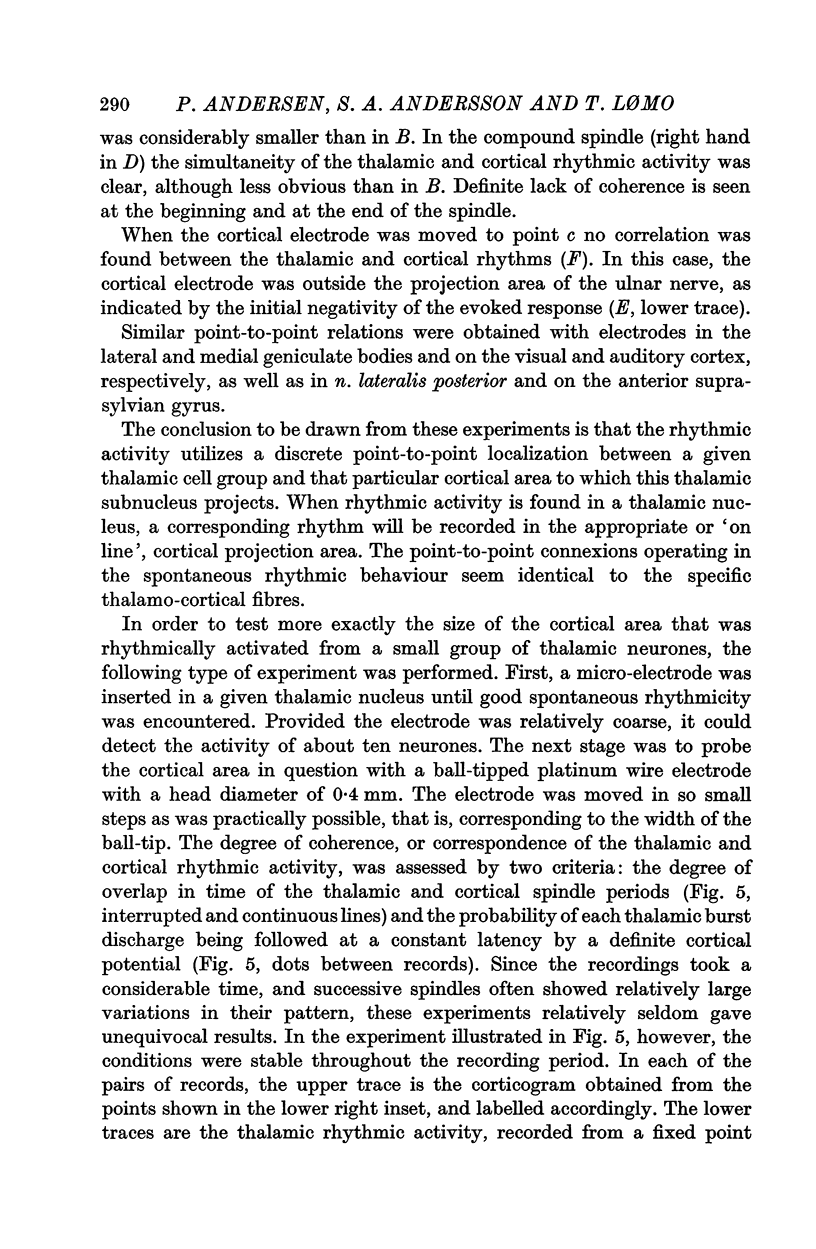Abstract
1. The relation between thalamic and cortical spontaneous spindles was investigated in cats anaesthetized with barbiturates.
2. Simultaneous recordings with multiple electrodes in the thalamus and cortex revealed a high correlation between thalamic and cortical spindle activity, both with regard to the occurrence of the spindles as well as to their individual waves, provided a critical location of the electrodes was secured. The results indicate a point-to-point relation between a group of thalamic cells and a small cortical area to which these cells project. In the spontaneous rhythm, the cortical columns are probably individually controlled by a thalamic rhythmic entity. This point-to-point relation was found in all the major sensory projection systems and in one thalamic `association' nucleus and its corresponding `association' cortex.
3. Cortical barbiturate spindles appeared either as local spindles in a restricted cortical area or as compound spindles in several areas. Spindles recorded from electrodes separated by 2 mm or more were clearly different with regard to intraspindle wave frequency, duration, and the time of start and stop of the spindle. These differences increased with increasing distance between the electrodes, and were most pronounced when the corticograms of the two hemispheres were compared.
4. Spontaneous spindle activity interfered with orthodromic transmission through n. ventralis posterolateralis (VPL) and medial geniculate nucleus (MG), judged by depression of the thalamic and cortical responses to peripheral nerve volleys or clicks. Such inhibition required the afferent volley to be delivered at a particular time of the spontaneous oscillations. Further, orthodromic volleys reset the rhythmic spindle waves in the appropriate thalamic and cortical areas.
5. These findings lead to a new concept of the thalamic pace-maker function. During barbiturate anaesthesia, small assemblages of thalamic neurones seem to have the ability to generate independent rhythmic discharges, and thereby control the rhythm of the particular cortical column to which this thalamic group projects.
6. During barbiturate anaesthesia, many facultative pace-makers seem to be present in the thalamus. The total number may be as large as 25,000-35,000. Usually, many of these rhythmic thalamic units beat in synchrony or near synchrony.
Full text
PDF
























Selected References
These references are in PubMed. This may not be the complete list of references from this article.
- AJMONE-MARSAN C., RALSTON B. Thalamic control of certain normal and abnormal cortical rhythms. Electroencephalogr Clin Neurophysiol. 1956 Nov;8(4):559–582. doi: 10.1016/0013-4694(56)90082-7. [DOI] [PubMed] [Google Scholar]
- ANDERSEN P., BROOKS C. M., ECCLES J. C., SEARS T. A. THE VENTRO-BASAL NUCLEUS OF THE THALAMUS: POTENTIAL FIELDS, SYNAPTIC TRANSMISSION AND EXCITABILITY OF BOTH PRESYNAPTIC AND POST-SYNAPTIC COMPONENTS. J Physiol. 1964 Nov;174:348–369. doi: 10.1113/jphysiol.1964.sp007492. [DOI] [PMC free article] [PubMed] [Google Scholar]
- ANDERSEN P., ECCLES J. Inhibitory phasing of neuronal discharge. Nature. 1962 Nov 17;196:645–647. doi: 10.1038/196645a0. [DOI] [PubMed] [Google Scholar]
- ANDERSEN P., SEARS T. A. THE ROLE OF INHIBITION IN THE PHASING OF SPONTANEOUS THALAMO-CORTICAL DISCHARGE. J Physiol. 1964 Oct;173:459–480. doi: 10.1113/jphysiol.1964.sp007468. [DOI] [PMC free article] [PubMed] [Google Scholar]
- ANDERSSON S. A., WOLPOW E. R. LOCALIZED SLOW WAVE ACTIVITY IN THE SOMATOSENSORY CORTEX OF THE CAT. Acta Physiol Scand. 1964 May-Jun;61:130–140. doi: 10.1111/j.1748-1716.1964.tb02948.x. [DOI] [PubMed] [Google Scholar]
- Andersen P., Andersson S. A., Lomo T. Patterns of spontaneous rhythmic activity within various thalamic nuclei. Nature. 1966 Aug 20;211(5051):888–889. doi: 10.1038/211888b0. [DOI] [PubMed] [Google Scholar]
- Andersen P., Andersson S. A., Lomo T. Some factors involved in the thalamic control of spontaneous barbiturate spindles. J Physiol. 1967 Sep;192(2):257–281. doi: 10.1113/jphysiol.1967.sp008299. [DOI] [PMC free article] [PubMed] [Google Scholar]
- BREMER F. Analyse oscillographique des réponses sensorielles des écorces cérébrale et cérébelleuse. Rev Neurol (Paris) 1952;87(2):65–92. [PubMed] [Google Scholar]
- BREMER F., BONNET V. Interprétation des réactions rythmiques prolongées des aires sensorielles de l'ecorce cérébrale. Electroencephalogr Clin Neurophysiol. 1950 Nov;2(4):389–400. doi: 10.1016/0013-4694(50)90076-9. [DOI] [PubMed] [Google Scholar]
- BREMER F. Cerebral and cerebellar potentials. Physiol Rev. 1958 Jul;38(3):357–388. doi: 10.1152/physrev.1958.38.3.357. [DOI] [PubMed] [Google Scholar]
- HANBERY J., JASPER H. Independence of diffuse thalamo-cortical projection system shown by specific nuclear destructions. J Neurophysiol. 1953 May;16(3):252–271. doi: 10.1152/jn.1953.16.3.252. [DOI] [PubMed] [Google Scholar]
- HUBEL D. H., WIESEL T. N. Receptive fields, binocular interaction and functional architecture in the cat's visual cortex. J Physiol. 1962 Jan;160:106–154. doi: 10.1113/jphysiol.1962.sp006837. [DOI] [PMC free article] [PubMed] [Google Scholar]
- HUBEL D. H., WIESEL T. N. Shape and arrangement of columns in cat's striate cortex. J Physiol. 1963 Mar;165:559–568. doi: 10.1113/jphysiol.1963.sp007079. [DOI] [PMC free article] [PubMed] [Google Scholar]
- JASPER H. H., AJMONE-MARSAN C. Thalamocortical integrating mechanisms. Res Publ Assoc Res Nerv Ment Dis. 1952;30:493–512. [PubMed] [Google Scholar]
- Kellaway P., Gol A., Proler M. Electrical activity of the isolated cerebral hemisphere and isolated thalamus. Exp Neurol. 1966 Mar;14(3):281–304. doi: 10.1016/0014-4886(66)90115-4. [DOI] [PubMed] [Google Scholar]
- MOUNTCASTLE V. B. Modality and topographic properties of single neurons of cat's somatic sensory cortex. J Neurophysiol. 1957 Jul;20(4):408–434. doi: 10.1152/jn.1957.20.4.408. [DOI] [PubMed] [Google Scholar]
- PURPURA D. P., COHEN B. Intracellular recording from thalamic neurons during recruiting responses. J Neurophysiol. 1962 Sep;25:621–635. doi: 10.1152/jn.1962.25.5.621. [DOI] [PubMed] [Google Scholar]


